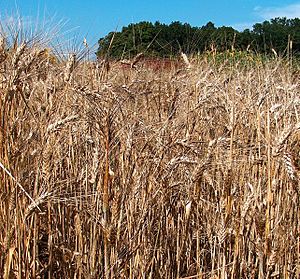Durum facts for kids
Quick facts for kids Durum |
|
|---|---|
 |
|
| Durum wheat | |
| Scientific classification | |
| Genus: |
Triticum
|
| Species: |
durum
|
Durum wheat, also known as pasta wheat or macaroni wheat, is a special type of wheat. It's called Triticum durum in science. This wheat is very important because it's the second most grown type of wheat in the world. About 5% to 8% of all wheat grown globally is durum wheat.
Durum wheat was first grown by people around 7000 BC. It came from an older type of wheat called emmer wheat. People in Central Europe and the Near East helped it become the "free-threshing" kind we know today. This means the grain comes out easily from its husks. Durum wheat has bristles, just like emmer wheat. It grows best in the Middle East.
The word durum comes from Latin and means "hard." This wheat is the hardest of all wheats. Its hardness makes it great for making semolina and pasta. It's not as easy to grind into regular flour for bread. Even though it has lots of protein, durum wheat doesn't make a very strong dough for bread. It has about 27% wet gluten, which is a bit more than common wheat.
Contents
What Makes Durum Wheat Special?
Durum wheat is a "tetraploid" wheat. This means it has four sets of chromosomes. In total, it has 28 chromosomes. Other common wheats, like those used for bread, are "hexaploid." They have six sets of chromosomes, making a total of 42.
Durum wheat came from two different types of wild grasses. Over time, they mixed and created this unique wheat.
How Durum Wheat is Used
Durum wheat is super important for making many foods you might eat!
Pasta and Couscous
Most dry pasta you buy in stores is made only from durum semolina. Many homemade fresh pastas, like orecchiette and tagliatelle, also use durum wheat.
When durum wheat is husked but not fully ground, it's used to make couscous. This is a popular dish in North Africa and the Levant. It's also used for other dishes like tabbouleh, kibbeh, and bulgur for pilafs. In North Africa and the Levant, durum wheat is used in many soups, puddings, and pastries.
Bread and Other Foods
When durum wheat is ground into a fine flour, it can be used to make bread. In the Middle East, it's often used for flat round breads. In Europe and other places, it can be used for pizza or torte. Couscous is a Middle Eastern dish made from small, boiled balls of durum wheat. In Israel, a larger version of couscous is called ptitim.
People have been using wheat to make pasta for a very long time. As early as the 10th century, a writer from Cairo described making a product called itrīya. This word later became tria in Italy.
Where Durum Wheat Grows
Most durum wheat grown today is "amber durum." Its grains are amber-colored because they have extra yellow pigments. These grains are also larger than other wheat types. When amber durum is milled, its yellow inside part turns into semolina. This semolina gives pasta its lovely yellow color. Semolina is also used for fancy pastas and breads. There's also a red durum, but it's mostly used to feed livestock.
Durum wheat grows very well in places that don't get much rain. It can still give good harvests with only a little water. Sometimes, farmers use irrigation to help it grow, but this is not common. In the early 1900s, a lot of durum wheat was grown in Russia.
Durum is a very important food crop in West Asia. Even though many types of wheat grow there, not enough durum is grown. So, it often needs to be imported. Amber durum from Canada is mostly used for pasta. Some is also sent to Italy to make bread.
In the Middle East and North Africa, about half of the durum wheat is used for making local breads. Some flour is even imported. Many countries in Europe also grow a lot of durum wheat for sale. In India, durum wheat makes up about 5% of all wheat grown. It's used to make products like rava and sooji.
Top Durum Wheat Producers (2017/2018)
| Producer | Production (million metric tonnes) |
|---|---|
| 151.6 | |
| 129.7 | |
| 98.5 | |
| 84.9 | |
| 47.3 | |
| 30.0 | |
| 26.9 | |
| 26.6 | |
| 21.5 | |
| 21.0 |
How Durum Wheat is Processed
Durum wheat goes through four main steps to become food: cleaning, tempering, milling, and purifying.
- First, it's cleaned to remove dirt and broken pieces.
- Then, it's tempered by adding moisture. This makes the outer layer of the grain tougher. This helps separate the bran (outer layer) from the endosperm (inner part).
- Next, durum wheat goes through milling. This is a complex process of grinding and sifting many times.
- Finally, purifying makes sure you get the most semolina with very little bran powder.
To make bread, durum wheat is ground into flour. This flour is mixed with water to make dough. The amount of water depends on how acidic the mixture is. Yeast and lukewarm water are added, and the dough is then left to ferment for several hours.
The quality of the bread depends on the protein in the wheat. Durum wheat has about 12% protein in its flour. This is a bit more than common wheat, which has about 11%.
Health Information
Durum wheat contains gluten. Because of this, it's not suitable for people who have problems with gluten. This includes conditions like celiac disease, non-celiac gluten sensitivity, and wheat allergy.
See also
 In Spanish: Trigo duro para niños
In Spanish: Trigo duro para niños

